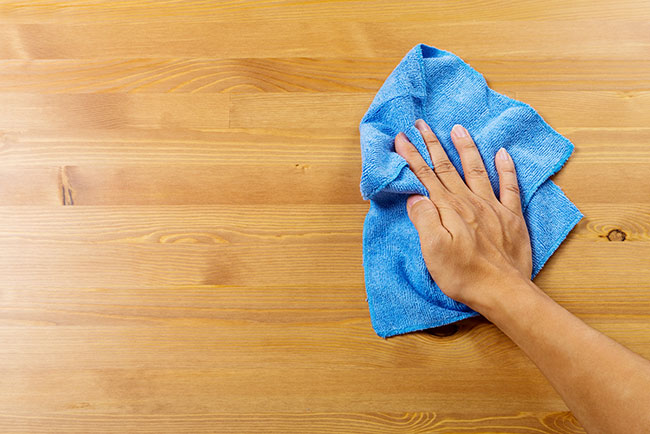Precautions and Care of Wooden Furniture at Home
Are you confused about the care of wooden furniture?
It usually depends on the finish of the piece. Even if you don’t need to fix solid wood furniture, time will take its toll. Like other household items, furniture can look worn after years of everyday use. Also, because wood is a natural element, it’s more vulnerable to other natural elements than pieces made from chemicals. Over the years, your classic furniture can start to look like old hand-me-downs.
Regular maintenance can slow the deterioration of hardwood furniture – or even prevent it altogether. Here are some of the best ways to preserve the beauty of your pieces:
- Dusting

Don't avoid dusting furniture. Frequent dusting removes airborne deposits that build up in a filmy layer and can scratch the surface. Clean, dry, soft cloths or feather dusters will effectively remove dust; however, to avoid scattering the dust into the air, where it floats until landing back on furniture surfaces, dampen the cloth very slightly.
Classic feather duster:
An ostrich-feather duster removes dust from easily damaged, delicate surfaces, such as silk lampshades, mirrors, picture frames and art, and fragile collectibles.
Treated cloths:
For dusting, soft, non-scratching clothes pick up and hold dirt. Use them in place of silicon sprays, which are not recommended for fine wood furniture.
Lamb's-wool duster:
These contain lanolin, which attracts dust and makes it cling to the cleaning tool. They're also effective for dusting carved or turned areas that clothes can't reach. A long handle makes them ideal for hard-to-reach areas, including light fixtures and ceiling fans.
Soft, lint-free cloth:
Clean cotton T-shirts or diapers are commonly used. Dampen them slightly to help trap dust.
Terry towels:
Use a clean dry towel to remove any moisture left from dusting with a damp cloth.
- Cleaning
Never use all-purpose cleaning sprays unless your furniture has a plastic coating, such as the kind used on kitchen tables and children's furniture.
You'll usually want to avoid cleaning wood with water. However, sticky spots may need to be treated with soap and water. Here's how: dip the cloth in mild soap or detergent dissolved in water, wring the cloth nearly dry, and wipe the area. Rinse and immediately dry with a clean, soft cloth.
- Oil polishes, cleaners, and furniture oils
They protect the wood by making the surface more slippery; they do not offer a hard protective layer. Products that contain a high percentage of oil make the surface smear, showing fingerprints. Avoid polishing with pure olive oil, which smears and attracts dust. Most commercial spray and liquid furniture polishes contain silicone oil, which provides some protection. If you have used sprays and polishes in the past or suspect that furniture has been polished with them, be aware that residues can interfere with refinishing and may need professional attention.

- Applying wax or polish
It protects the manufacturer's finish and helps to reduce surface scratches.
Wax provides a hard finish and long-lasting protection doesn't smear and is more durable than sprays or polishes.
Use paste wax or liquid wax made specifically for furniture. Depending on use, paste wax finishes may last as long as two years. Liquid wax is easier to apply but leaves a thinner coating; it may need to be applied more frequently than paste wax.
Always apply wax in light coats, rubbing it into the surface with the grain. Allow to dry and buff to a clear shine with a soft cloth.
Tips for Applying Paste Wax:
- Put a spoonful of wax, about the size of a golf ball, in a square of 100-percent-cotton fabric. Wrap the fabric around the wax ball and knead it until it becomes soft.
- Rub in a circular motion, one small area at a time, until the waxing is complete.
- When the surface dulls, wipe off the excess wax. Use a clean, soft cotton cloth and turn it frequently.
- Repeat waxing and wiping until the entire piece is waxed. If you notice a streak, keep wiping to remove excess wax.
- Polish the wood, with a soft cloth or lamb's-wool pad attached to an electric drill or power buffer. If the wax smears, wipe with a soft cloth and continue buffing.
- For a deep shine, apply a second coat of wax in the same manner; to maintain waxed furniture, dust with a lamb's-wool duster. Never use liquid or aerosol furniture polishes because they can dissolve the wax and leave a hazy film.
- Cleaning and care routine
- Clean approximately every year with a commercial cleaning product. Work with the grain and follow product directions carefully.
- Restore as needed, especially from sun fading, using a commercial finish restoring product such as Howard Restore-A-Finish. Choose a shade closest to the wood stain. Work with the grain of the wood and use light to moderate pressure. Immediately wipe with a soft, lint-free cloth, such as cheesecloth.
- Feed as a monthly routine using an orange oil or wax to prevent drying and cracking.
- Deep Cleaning
As a first step to removing layers of grime, use oil soap, and water. Rinse and dry well. If the finish still seems dirty, clean lightly with steel wool dipped in a cleaning product. Some products with a milky appearance are formulated to dissolve both solvent-based and oil-based residues. Do not use mixtures containing boiled linseed oil, turpentine, or white vinegar. Museum conservators say these things darken the wood and attract dust and lint. Instead, apply clear paste wax.
- Freshen Finds
- If a vintage piece has a lingering smell, the air outside on a warm, dry day. Shade from direct sunlight.
- Pour talcum powder or baking soda over the surface to absorb odors.
- Place a shallow pan of charcoal briquettes inside drawers.
- Rub the upper edge of sticking drawers with a white candle.
- Polishing Hardware
Remove hardware from the furniture piece. Clean with a metal or brass cleaner and buff. Reattach when completely dry.
- Scratching the Surface
If the top of wood furniture is slightly scratched, apply paste wax or use a felt-tip touch-up pen.
To treat deeper scratches that gouge into the wood, use wood filler or a colored filler wax stick available at hardware and home improvement stores. Match as closely as possible to the color of your piece, applying in several thin layers rather than one thick layer.
- Prevent Infestation
Bugs are never welcomed at homes, but certain bugs will literally eat you out of house and home, including wooden furniture. It’s much harder to resolve an infestation than to prevent one.
So follow EPA guidelines and keep wooden beetles and termites at bay before they destroy your real hardwood furniture.
- Keep used Surface Cover
Whenever you do something on wooden furniture, you compromise the quality. Cover up those used areas to protect your investment. Place tablecloths and placemats on dining tables, for instance, and place felt pads under the lamps on your end tables. Also, keep coasters nearby- it doesn’t take long for a water ring to form on a table surface.
- Quick Repairs
One reason wooden furniture can last such a long time is that most damage is easy to fix. Anything made from cheap material tends to break easily, and anything made with fabric loses its luster once the material rips. By contrast, hardwood furniture is sturdy and can withstand most mishaps.
The biggest challenge of repairing furniture is what to use. You want something that gets rid of the damage without destroying the finish. Wood-repair kits are available online and in stores, or you could do it yourself using:
- Pumice, a mild abrasive that can sand down or smooth out a damaged surface
- Mineral spirits, a great alternative to turpentine
- Linseed oil, also sold as flaxseed oil, solidifies to create a shiny surface.
- Leather Care
Leather upholstery should be dusted regularly and wiped down with a slightly damp cloth. Never use wax, polish, or oil cleaners. A Leather Conditioner would be recommended for keeping your leather fresh and brings out the color. Using a soft cloth to buff the leather after cleaning will add luster to the leather. Spots and Spills: Blot excess liquid immediately with a clean absorbent cloth or sponge.
- Spills and White Rings
This is why you need to keep coasters nearby. Sweat from a cold glass or heat from a hot beverage can penetrate the finish and leave a white ring on your tabletop. Try blowing a hairdryer on the affected area. If that doesn’t work, rub car wax, petroleum jelly, or toothpaste on the area, and then wipe away with a damp cloth. Whatever remedy you use, use it right away. Moisture can travel far below the surface, and the longer it penetrates the harder it is to remove.
- Ink Stains
Ink stains can be difficult to remove from solid wood furniture, but not impossible. To get rid of ink, mix baking soda and water and pour the mix over the stain. Wipe it off with a damp cloth. Treated surfaces would do better with a mix of water and dishwashing liquid. Test a small spot before treating the whole stain – you don’t want to remove a stain and damage the finish in the process.



































